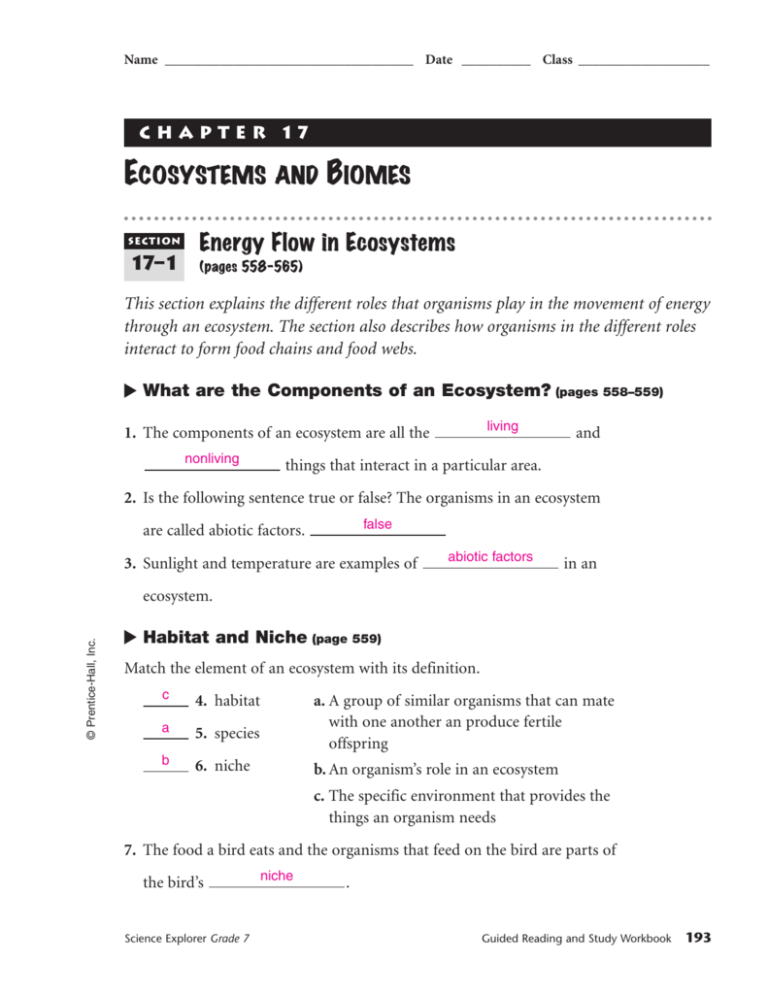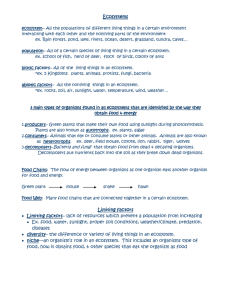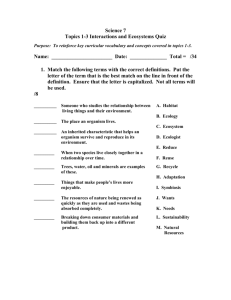Section 17-1 (answers)
advertisement

Name ____________________________________ Date __________ Class ___________________ CHAPTER 17 ECOSYSTEMS AND BIOMES SECTION 17–1 Energy Flow in Ecosystems (pages 558-565) This section explains the different roles that organisms play in the movement of energy through an ecosystem. The section also describes how organisms in the different roles interact to form food chains and food webs. What are the Components of an Ecosystem? (pages 558–559) living 1. The components of an ecosystem are all the nonliving and things that interact in a particular area. 2. Is the following sentence true or false? The organisms in an ecosystem false are called abiotic factors. 3. Sunlight and temperature are examples of abiotic factors in an © Prentice-Hall, Inc. ecosystem. Habitat and Niche (page 559) Match the element of an ecosystem with its definition. c 4. habitat a 5. species b 6. niche a. A group of similar organisms that can mate with one another an produce fertile offspring b. An organism’s role in an ecosystem c. The specific environment that provides the things an organism needs 7. The food a bird eats and the organisms that feed on the bird are parts of the bird’s Science Explorer Grade 7 niche . Guided Reading and Study Workbook 193 Name ____________________________________ Date __________ Class ___________________ CHAPTER 17, Ecosystems and Biomes (continued) Energy Roles (pages 560–562) Match the energy role with its definition. Energy Role c 8. producer b 9. consumer a Definition a. Organism that breaks down wastes and dead organisms b. Organism that obtains energy by feeding on other organisms 10. decomposer c. Organism that can make its own food 11. What types of organisms are producers? Producers include plants, algae, and certain microorganisms. 12. Is the following sentence true or false? Energy enters all ecosystems as sunlight. false 13. Is the following sentence true or false? Producers are the source of all the food in an ecosystem. true 14. List two major groups of decomposers. a. bacteria b. fungi © Prentice-Hall, Inc. 15. Complete the compare/contrast table. Types of Consumers Type of Consumer Type of Food Herbivore Only plants Carnivore Only animals Omnivore Both plants and animals Scavenger Dead organisms 194 Guided Reading and Study Workbook Science Explorer Grade 7 Name ____________________________________ Date __________ Class ___________________ 16. Is the following sentence true or false? Decomposers return raw true materials to the environment. Food Chains and Food Webs (pages 562–564) 17. What is a food chain? A food chain is a series of events in which one organism eats another and obtains energy. 18. Label the producer and the first-level and second-level consumers in the food chain. Second-level consumer Kestrel First-level consumer Grass Mouse © Prentice-Hall, Inc. Producer 19. The many overlapping food chains in an ecosystem make up a(n) food web . 20. Circle the letter of each sentence that is true about a food web. a. Producers are at the top of the food web. b. All first-level consumers are carnivores. c. Second-level consumers may be carnivores or omnivores. d. An organism may play more than one role in a food web. Science Explorer Grade 7 Guided Reading and Study Workbook 195 Name ____________________________________ Date __________ Class ___________________ CHAPTER 17, Ecosystems and Biomes (continued) Energy Pyramids (pages 564–565) 21. What does an energy pyramid show? It shows the amount of energy that moves from one feeding level to another in a food web. 22. Circle the letter of each sentence that is true about an energy pyramid. a. The greatest amount of energy is available at the producer level. b. At each level of the pyramid, there is more energy available. c. About half the energy at one level is transferred to the next. d. Most food webs have only three or four feeding levels. 23. Name the levels in an energy pyramid, starting with the base of the pyramid. a. Producers b. First-level consumers c. Second-level consumers d. Third-level consumers 24. Why are there usually few organisms at the top of a food web? There are usually few organisms at the top because there is a limited amount of energy available at that level of a food web. © Prentice-Hall, Inc. Reading Skill Practice Outlining is a way to help yourself understand and remember what you have read. Write an outline of this section on energy flow in ecosystems. In an outline, copy the headings in the textbook. Under each heading, write the main idea of that part of the lesson. Then list the details that support each main idea. Outlines should be organized under the headings What Are the Components of an Ecosystem?, Habitat and Niche, Energy Roles, Food Chains and Food Webs, and Energy Pyramids and include information from pages 558–565. 196 Guided Reading and Study Workbook Science Explorer Grade 7









